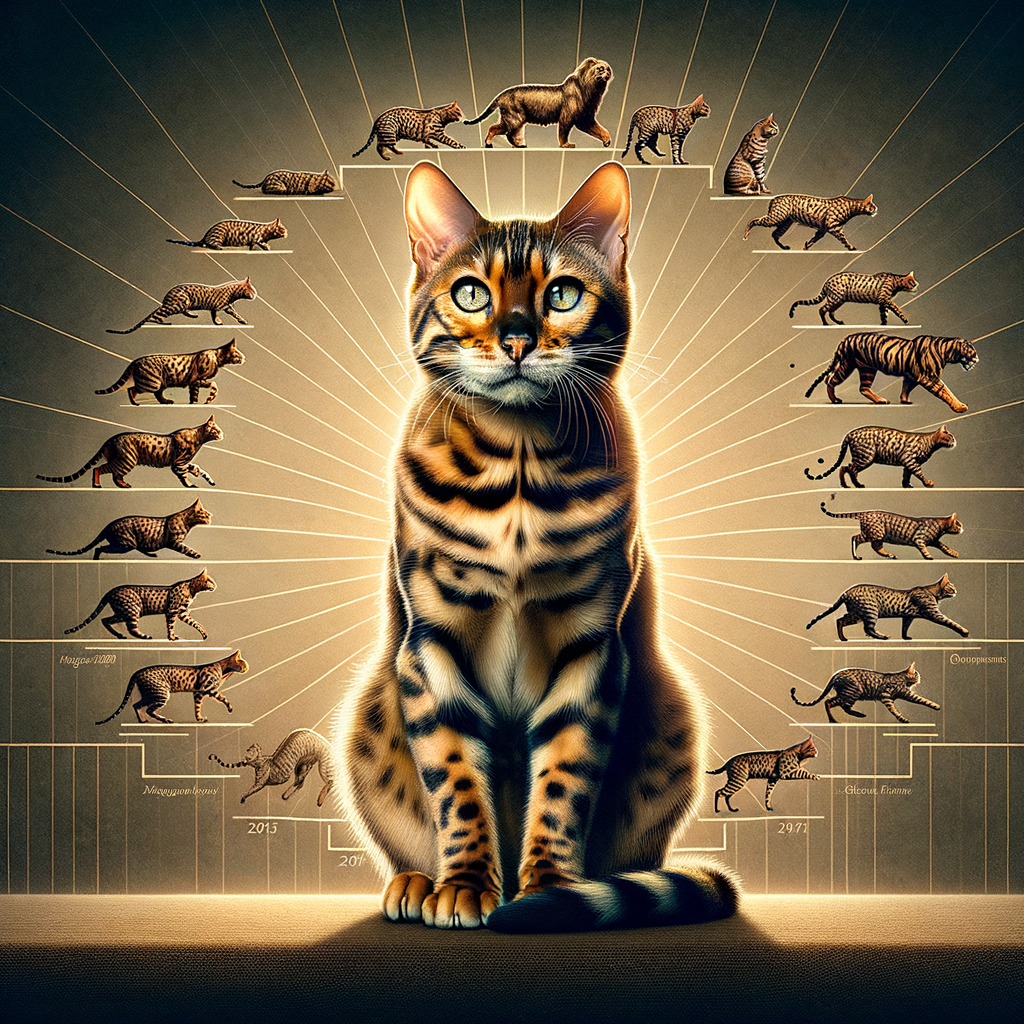
The Fascinating History of Bengal Cats: An Overview
- Introduction to Bengal Cats: Bengal cats are a unique and captivating breed known for their striking appearance and playful nature. They are often recognized by their leopard-like spots and sleek, muscular bodies.
- Origins of the Breed: The Bengal cat breed was developed in the United States during the 1970s. The breed originated from a cross between domestic cats and the Asian leopard cat, a small wild cat native to Asia.
- Evolution Over Time: Over the years, breeders have worked to refine the Bengal cat’s characteristics. Early generations were more wild in behavior, but through careful breeding, Bengals have become more domesticated while retaining their exotic looks.
- Current Status and Popularity: Today, Bengal cats are highly popular among cat enthusiasts. They are known for their intelligence, energetic personality, and striking appearance. Bengals are often featured in cat shows and are cherished as pets worldwide.
Bengal Cat Origins: The Beginning
- Origins in the Wild: Bengal cats have a fascinating history that starts in the wild. They are descendants of the Asian leopard cat, a small wild cat found in Asia. These wild cats have striking spots and rosettes on their fur, which is a key feature of Bengal cats today.
- First Domestication Efforts: The journey to domesticate Bengal cats began in the 1960s. Breeders wanted to create a cat that looked wild but had the temperament of a domestic cat. The first successful efforts involved crossing the Asian leopard cat with domestic cats.
- Role of Jean Mill in Bengal Cat Breed History: Jean Mill played a crucial role in the history of Bengal cats. In the 1980s, she was one of the first breeders to successfully create a new breed from the Asian leopard cat and domestic cats. Her work helped establish the Bengal cat as a recognized breed.
The Evolution of Bengal Cats: From Wild to Domestic
-
Early Breeding Efforts and Challenges
The journey to create the Bengal cat began in the 1960s. Breeders wanted a cat that looked wild but had a friendly nature. They started by crossing domestic cats with Asian leopard cats. This was not easy. The first generations were often sterile, and the kittens had wild behaviors.
One of the first breeders, Jean Mill, faced many challenges. She had to find the right balance between wild and domestic traits. It took many years of trial and error. But she did not give up. Her hard work laid the foundation for the Bengal cat we know today.
-
Development of Bengal Cat Lineage
Over time, breeders improved their techniques. They carefully selected cats for breeding. This helped to create a stable Bengal cat lineage. By the 1980s, the Bengal cat started to gain recognition. Breeders focused on keeping the wild look while making sure the cats were friendly and playful.
One key milestone was the recognition by The International Cat Association (TICA) in 1983. This helped to standardize the breed. Breeders from around the world began to work together. They shared their knowledge and experiences.
-
Changes in Appearance and Temperament Over Time
The Bengal cat has changed a lot since the early days. Originally, they had a more wild appearance. Over the years, breeders have refined their looks. Today, Bengal cats have a sleek, muscular body. Their coat is short and dense, with striking spots or marbled patterns.
Temperament has also improved. Early Bengals were more wild and less predictable. Modern Bengals are known for being friendly and energetic. They enjoy playing and interacting with their owners. These changes have made the Bengal cat a popular choice for pet lovers.
Historical Bengal Cats: Key Figures and Moments
- First Recognized Bengal Cat: The first Bengal cat was recognized in the 1980s. Jean Mill, a breeder from California, played a key role in developing the breed. She crossed an Asian leopard cat with a domestic cat to create the first Bengal.
- Notable Bengal Cats in History: One famous Bengal cat is “Millwood Tory of Delhi.” This cat was one of the first Bengals to be shown in cat shows. Another notable Bengal is “Cato,” who appeared in various commercials and TV shows, showcasing the breed’s beauty and agility.
- Key Moments in Bengal Cat Heritage:
- 1983: The Bengal cat was officially accepted by The International Cat Association (TICA).
- 1991: The breed gained championship status in TICA, allowing Bengals to compete in cat shows.
- 2000s: Bengal cats became popular pets worldwide, known for their wild appearance and friendly nature.
The Development of Bengal Cats: Modern Breeding Practices
-
Modern Breeding Techniques
Bengal cats are bred using advanced techniques to ensure healthy and beautiful kittens. Breeders use selective breeding to choose the best traits. This means they pick parent cats with the best qualities to create even better kittens.
One common technique is line breeding. This method involves breeding cats that are closely related. It helps to keep the good traits strong in the kittens. Another technique is outcrossing. This means breeding Bengal cats with other breeds to bring in new traits and improve health.
-
Role of Genetics in Bengal Cat Evolution
Genetics play a big role in how Bengal cats look and act. Breeders study the genes of the cats to understand which traits will be passed on to the kittens. This helps them to create cats with beautiful coats and friendly personalities.
For example, the spotted coat of a Bengal cat comes from a special gene. Breeders look for this gene when choosing parent cats. They also look at health genes to make sure the kittens will be strong and healthy.
-
Current Standards for the Breed
There are specific standards that Bengal cats must meet to be considered purebred. These standards are set by cat organizations like The International Cat Association (TICA).
Some of the key standards include:
- Coat: Should be short, soft, and have a spotted or marbled pattern.
- Body: Muscular and athletic with a sleek appearance.
- Head: Small in proportion to the body with large eyes and ears.
Meeting these standards ensures that the Bengal cats are true to their breed and have the best qualities.
Bengal Cat Background: The Breed’s Characteristics
- Physical characteristicsBengal cats are known for their striking appearance. They have a sleek, muscular body and a beautiful coat. Their fur is short and soft, often with a glittery effect. The coat patterns can be spotted or marbled, resembling those of wild cats. Bengals usually have large, almond-shaped eyes that can be green, gold, or blue.
- Temperament and behaviorBengal cats are very active and playful. They love to climb, jump, and explore their surroundings. These cats are also very intelligent and can learn tricks. Bengals are known to be affectionate with their families but can be wary of strangers. They enjoy interactive play and need plenty of mental and physical stimulation.
- Health and lifespanBengal cats are generally healthy, but they can be prone to certain genetic conditions. Some common health issues include hip dysplasia, heart disease, and certain eye conditions. With proper care, Bengals can live up to 12-16 years.
| Characteristic | Details |
|---|---|
| Coat | Short, soft, spotted or marbled |
| Eyes | Large, almond-shaped, various colors |
| Temperament | Active, playful, intelligent |
| Lifespan | 12-16 years |
Bengal Cat Ancestry: A Look at the Breed’s Wild Relatives
-
Comparison with Asian Leopard Cats
The Bengal cat has a fascinating ancestry that includes the Asian leopard cat. These wild cats are small, spotted felines found in Asia. They are known for their beautiful coats and agile nature.
Asian leopard cats are more solitary and shy compared to domestic cats. They prefer to live in forests and are excellent climbers. Bengal cats inherited some of these traits, making them unique among domestic breeds.
For more information about Asian leopard cats, you can visit their Wikipedia page.
-
Similarities and Differences with Other Domestic Cats
Bengal cats share some traits with other domestic cats, but they also have distinct differences. Like many house cats, Bengals are playful and affectionate. However, their wild ancestry gives them a more energetic and curious nature.
Unlike most domestic cats, Bengals love water. They often enjoy playing in it, which is a trait they get from their wild relatives. Their coats are also different, with a unique pattern that resembles a leopard’s spots or a tiger’s stripes.
-
The Bengal Cat’s Unique Traits
Bengal cats are known for their striking appearance and lively personality. Their coats are not only beautiful but also soft and sleek. They come in various colors and patterns, including spotted and marbled.These cats are very active and need plenty of exercise. They enjoy climbing, jumping, and exploring their surroundings. Bengals are also very intelligent and can learn tricks and commands easily.
One of the most unique traits of Bengal cats is their vocalization. They are very talkative and use different sounds to communicate with their owners.
| Trait | Description |
|---|---|
| Coat | Spotted or marbled, soft and sleek |
| Personality | Energetic, curious, and playful |
| Intelligence | Highly intelligent, can learn tricks |
| Vocalization | Very talkative, uses various sounds |
| Love for Water | Enjoys playing in water |
The Ongoing Evolution of Bengal Cats
The Bengal cat has come a long way from its wild ancestors. Today, it is a beloved pet known for its beauty and playful nature. Let’s look at some current trends, future predictions, and final thoughts on this fascinating breed.
- Current trends in Bengal cat breeding: Breeders are focusing on enhancing the Bengal’s unique coat patterns and colors. There is also a growing interest in ensuring the health and temperament of these cats. Ethical breeding practices are becoming more popular, with a focus on reducing genetic disorders.
- Future predictions for the breed: As technology advances, we may see even healthier and more diverse Bengal cats. Genetic testing can help breeders make better choices, leading to stronger and healthier cats. The demand for Bengals is likely to grow as more people learn about their unique qualities.
- Final thoughts on the Bengal cat’s fascinating history: The Bengal cat’s journey from wild to domestic is truly remarkable. From its origins in the wild to becoming a cherished pet, the Bengal cat has captured the hearts of many. Its history is a testament to the dedication of breeders and cat lovers around the world.
| Aspect | Details |
|---|---|
| Coat Patterns | Rosetted, marbled, and spotted |
| Health Focus | Reducing genetic disorders |
| Future Trends | Advanced genetic testing |
| Popularity | Increasing demand |
The Bengal cat continues to evolve, and its future looks bright. Whether you are a breeder, owner, or simply a cat lover, the Bengal cat’s story is one of innovation and passion. As we move forward, we can look forward to seeing even more amazing developments in this extraordinary breed.






